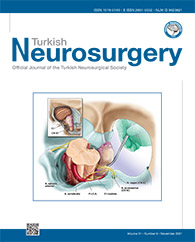2Zibo Municipal Hospital, Department of Endocrine, Zibo City, Shandong Province, China
3Zibo Municipal Hospital, Department of Radiology, Zibo City, Shandong Province, China DOI : 10.5137/1019-5149.JTN.30830-20.2 AIM: To explore the predictive values of serum biochemical markers and apparent diffusion coefficient (ADC) on delayed encephalopathy after acute carbon monoxide poisoning (DEACMP).
MATERIAL and METHODS: Seventy-nine patients were divided into two groups based on the onset of DEACMP 60 days after with acute carbon monoxide poisoning. The baseline data of ACMP patients were collected. Serum levels of cardiac troponin I (cTNI), lactic acid (Lac), carboxyhemoglobin (COHb), creatine kinase (CK), creatine kinase isoenzyme (CK-MB), lactate dehydrogenase (LDH), C-reactive protein (CRP), and neuron-specific enolase (NSE) were measured within 24 hours of ACMP onset. The ADC of globus pallidum, centrum semiovale, and periventricular white matter were recorded by diffusion-weighted magnetic resonance imaging (DW-MRI) within 48 hours of admission. Logistic regression analysis was performed to determine the risk factors for DEACMP.
RESULTS: The incidence of coma and duration of poisoning in the DEACMP group were significantly higher than those in the non-DEACMP group. The levels of Lac, CK, CK-MB, LDH, CRP and NSE in the DEACMP group were higher than those in the non- DEACMP group. The ADC value of globus pallidus in the DEACMP group was significantly higher than that in non-DEACMP group. The duration of poisoning, coma degree, CK, LDH, NES, and CRP were closely associated with the occurrence of DEACMP.
CONCLUSION: The duration of poisoning, coma degree, and serum levels of CK, LDH, CRP, and NSE were independent risk factors for DEACMP.
Keywords : Carbon monoxide poisoning, Coma, Creatine kinase, Neuron-specific enolase, Magnetic resonance imaging




